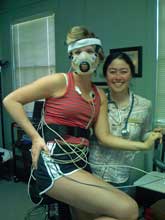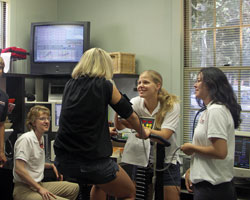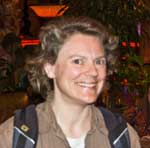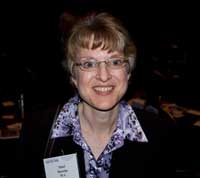The IACFS/ME Conference Reports # V
Whacking Those Patients – The Exercise Studies



Reno, Nevada: March 12-16, 2009
By Cort Johnson
______________________________________________________________________________________________________________
Whack Those Patients!
Two years ago repeat exercise tests at the 2007 Fort Lauderdale IACFS/ME showed ME/CFS patients falling apart metabolically on their second exercise test. Dr. Whistler was impressed enough with her results to call for stress tests of one sort or another to be used in every study. One of the most intriguing themes of the conference is the degree to which repeat exercise tests are beginning to pervade the research arena.
More Stress = Better Results: The Call Goes Out to Whack ME/CFS Patients
Natural Killer Cell Function is Depressed in Gulf War Illness. Toni Whistler, Mary Fletcher, W. Loneragan, S. Vernon and Nancy Klimas.
Toni Whistler was excited – I could hear it in her voice. She was reporting on natural killer cell (NK) functioning in Gulf War Syndrome (GWS) patients. She had put them through an exercise stress test and then measured their NK cell functioning. She wanted to make it clear how important she felt exercise tests were. She stated it twice. Both times I could hear her voice rise as she emphatically stated that “challenge studies (e.g. exercise tests/stress tests) are critical for finding differences between chronic fatigue syndrome patients and controls;” i.e., to get strong results you’re probably to have to whack your patients pretty hard.
your patients pretty hard.
Natural killer cells man the lines of our first immune response. They troll about inspecting cells to see if they’re defective or infected or cancerous. If they find a bad cell, they kill it and raise the alarm. We know the natural killer cells are not tracking down and killing infected cells like they should in this disease and it appears (unfortunately) that, at least in some patients, they’re not tracking down cancerous cells either. This study took natural killer cell research to the next level; they examined the gene expression (gene activity) before and after exercise to see if different genes were active in the GWS and healthy controls.
The need for a stress test of some sort is really no secret – the research community is finally catching on to a pattern that’s been obvious for some time now. Studies that measure patients at baseline (at rest) often do not have positive results but studies that somehow stress whatever system they’re studying often do. Dr. Whistler also underscored a broader need that came up again and again during the conference and reached a peak with Dr. Vernon’s address – the need for research standards in this disease.
Why do an exercise test for a study on natural killer cell functioning? Apparently NK cells spill out of the lymphoid organs (lymph nodes, spleen) and rush into the blood when we exercise. They obviously do that for a reason. Staci Stevens has suggested that the post-exertional malaise in ME/CFS could be due to immune dysfunction . One wonders if that immune dysfunction somehow involves malfunctioning NK cells.
What are they trying to get at? One suspects gene networks that influence natural killer cell activity. Dr. Vernon recently published a paper suggesting that immune cells network differently in chronic fatigue syndrome patients. Instead of the efficient, streamlined immune networks found in healthy people she found large fragmented networks in ME/CFS patients. Essentially those large well integrated networks of immune cells that work together to produce a powerful immune response just aren’t found in many ME/CFS patients.
This study found that 49 genes involved in NK cell function had increased activity in the healthy controls but only nine genes had increased activity in the GWS patients. This suggests that a big chunk of the essential gene activity needed for a healthy NK cell response is just not occurring in GWS (or ME/CFS). (Dr. Whistler stated that the two groups are essentially similar) Interestingly, the activity of the gene for perforin – the shells that make up the NK cell’s heavy artillery – was lower in GWS patients. Low perforin levels have been a hallmark finding in ME/CFS.
A Natural Killer Cell Disease? The Fletcher/Klimas team in Miami started this work about 20 years ago and the closer they’ve looked the more they’ve found. Thus far they’ve been the only research team to take this on. (Why the CDC has never incorporated NK cell studies into their research is puzzling. They have never gone so far (so far as I can tell) as to measure the activity of a single natural killer cell in all their studies). Now the Whittemore-Peterson Institute is stepping into the gap. Later in the conference Dr. Mikovits will pinpoint a defect in the natural killer cells in Dr. Peterson’s Reno cohort that could prevent them from identifying infected cells . Natural killer cell problems appeared to be at the heart of the immune dysfunction in many ME/CFS patients.
Collaboration Works! This study was an excellent example of the kind of collaborative effort Dr. Vernon has been proposing (and initiating at the CAA). It included researchers from the CDC (Dr. Whistler), the CFIDS Association of America (Dr. Vernon) and Fletcher/Klimas team in Miami. Given Dr. Whistler’s affiliation with the CDC – the same group that relegated the post-exertional fatigue symptom to irrelevance in their latest definition – it was startling to hear her make the call for more exercise stress tests. One wonders how far her views will carry at that group.
Exercise and Hormones in Spain
Suarez, A, Javierre, C. Alegre, J. etc. al. Hormonal Evaluation in the Chronic Fatigue Syndrome
This group loaded the deck with their patients: they didn’t just work them; it sounded like they almost beat them to death. If I got this right – and it wasn’t easy figuring it out – instead of exercising for two days they had their patients exercise for three days straight. Instead of working them to exhaustion once a day they worked them to exhaustion three times a day. After each workout they were allowed to rest for 3 minutes then back they went pedaling until their legs went numb again. (Presumably those legs very quickly went numb the second and third times). Afterwords Dr. Suarez told me they had some very sick people participating….If they weren’t very sick going in they certainly must have been afterwards. 
In any case these chronic fatigue syndrome patients did not show reduced exercise capacity (VO2 max) relative to the controls on the first day, the second day or the third day! (I started getting a sinking feeling in my stomach – had the Pacific Fatigue Lab research already been upended? Was another dream taken away so soon? If so – this would surely be a record! I had just talked to Eleanor Stein whose small study had shown the same thing – no repeat exercise differences in her study.)
These patients did, however, show reduced cortisol levels; in fact, every day the ME/CFS patients had lower and lower levels of cortisol relative to the controls. This is intriguing since cortisol does control glucose uptake (i.e. energy) to the muscles. It ensures that the muscles get the energy they need during stressful situations like exercise. These ME/CFS patients were getting less cortisol precisely at the point they most needed it. Other hormonal indicators such as growth hormone, prolactin and ACTH, on the other hand, were normal.
There’s plainly no getting away from cortisol in this disease. While it’s only mildly low, it’s still mildly low again and again and again. This study suggests that cortisol levels in ME/CFS patients begin a bit low and they tank during exercise.
NOOOOOOO! It’s Happening Again! (Or is it?)
Tolerance to Repeated Maximal Exercise in ME/CFS. E Taub. E. Stein and B. MacIntosh.
I came across this poster before Dr. Van Ness gave his presentation (see below) and shot Dr. Stein a rather angry look. How could you, I thought? How could you debunk this great theory? How dare you? Objectivity was definitely thrown to the winds. Five females with ME/CFS bicycle to exhaustion two days in a row and their VO2 Max results don’t budge…a t all. They were as strong metabolically the second day as they were the first day. This looked to set a record for hopes dashed – just in the last month I’d sent out a newsletter suggesting that the repeat exercise studies could be ‘IT’ in this disease – and now this….
t all. They were as strong metabolically the second day as they were the first day. This looked to set a record for hopes dashed – just in the last month I’d sent out a newsletter suggesting that the repeat exercise studies could be ‘IT’ in this disease – and now this….
After talking to Dr. Stein, though, it was hard to get upset with her. She, herself has had ME/CFS for many years. She’d done the study hoping and expecting that the results would be different. She assured me that all the participants had had strong post-exertional fatigue but that they just didn’t have ‘metabolic dysfunction’.
This means that post-exertional fatigue is not necessarily synonymous with metabolic dysfunction – you could be wiped out by exercise and still not have ‘metabolic dysfunction’. (One wonders if the opposite is true as well – I know of one patient who was able to exercise even when his VO2 levels were quite low.) When I asked Staci Stevens about the study, she said the participants had had pretty high VO2 maxes to start off with – and that could have made a difference.
The Metabolic Subset
A Diagnostic Test for the Identification of Metabolic Dysfunction. J. VanNess, Staci Stevens, K. Kumasaka, H. Singh, et. al.
The title says it all; ‘A Diagnostic Test for the Identification of Metabolic Dysfunction‘ – not chronic fatigue syndrome. Despite the CDC’s effort to expand the parameters of this disease (‘unwellness syndrome’?) we are slowly seeing the beginning of the end of chronic fatigue syndrome name and the breaking up of the disease. The research community appears to sense that the era of ‘subsets’ is upon us.
In his opening remarks HYPERLINK Dr. Peterson stated that the search for A biomarker is over, that it’s all about subsets now. The Whittemore-Peterson Institute believes they’ve found immune biomarkers for a subset of patients. If they have, they’ve cut a whole chunk of ME/CFS patients free from the chronic fatigue syndrome label. Both Staci Stevens and Dr. Klimas implored the CDC to go after subsets at the public review of the CDC’s draft strategic plan. 
The Pacific Fatigue Lab’s presentation was about nailing down that metabolic dysfunction subset, those patients whose metabolic tests undergo inexplicable declines during a second exercise test. The Pacific Fatigue Lab presented data from a broad range of results from their studies and disability evaluations, the Montoya Valcyte Study and some patients from a practitioner in Ithaca, New York. About 40% of their group, 40% of patients from Ithaca (7 patients), 55% of Dr. Montoya’s patients and about 70% of people doing disability evaluations at the PFL met the threshold for ‘metabolic dysfunction’. At this point it appears that somewhere around half the patients thus far tested have this problem.
The percentages may be higher. Dr. Van Ness remarked on the possibility that a ‘physiological floor’ could be obscuring some of the results. Apparently some people who have very low VO2 max scores the first day had similar scores the next day as well. This could mean there’s a floor you can’t get lower than (and still be alive?).
The tests are not necessarily representative of the population at large; the PFL won’t do tests if you’re too ill and there are presumably a lot of healthier patients who have considerable fatigue and impaired functioning who don’t fit into the high EBV or disability group.
Unfortunately the Pacific Fatigue Lab has been another casualty in the NIH Grant meat grinder; they spent six months or so putting together a several hundred page grant application and were denied – in no small part because they weren’t allied with a major institution. Staci Steven suggested they probably won’t undergo that process soon again.
Dig Deeper: Check out ‘Cracking the Foundations’ for more on the Pacific Fatigue Lab’s Work
NOOOOOOO! Is it NO after all?
A Diagnostic Method for the Evaluation of Chronic Fatigue Syndrome? A Suarez, C. Javierre, T. Roig, et. al.
This was just a single exercise test but that’s all it took; 37 chronic fatigue syndrome (ME/CFS) patients blew their healthy counterparts away with higher (much higher) nitrate levels in their blood (but not lactate or glucose) levels after a single exercise test.
This was definitely new. Several studies have looked for abnormal lactate levels – a common finding in muscle dysfunction – but their findings have been inconsistent. But now nitrates show up – in spades – in ME/CFS patient’s blood. Not only that but it’s a very strange finding.
Nitrate in the blood is derived from nitric oxide (NO) which the endothelial cells lining our blood vessels produce in order to increase the size of the blood vessels (and increase blood flows). These findings then suggest that these patient’s blood vessels were too open. Usually in disease it’s just the opposite they’re too narrowed.
Nitrates are often given to heart patients in order to increase blood vessel dilation and improve blood flows to the heart. They are used to increase exercise capacity! but here we have these exercise-impaired patients with higher than normal nitrate levels!
Interestingly, in Italo Biaggoni’s NIH-funded study he is looking for signs of the opposite situation – decreased endothelial nitric oxide production. It’s hard to know what to make of this little study. Will it simply be another odd blip on the ME/CFS radar or will it amount to something? Only time will tell.
Dig Deeper! For More Reno IACFS/ME Conference Overviews
- Treatment Section Part I and Part II
- The Hit of the Conference” The Whittemore-Peterson Neuro-immune Institute
- Surprise of the Conference
- Whack Those Patients – The Exercise Studies
- Rocking the Conference – Rocking the Research World: Dr Suzanne Vernon at the Mic
